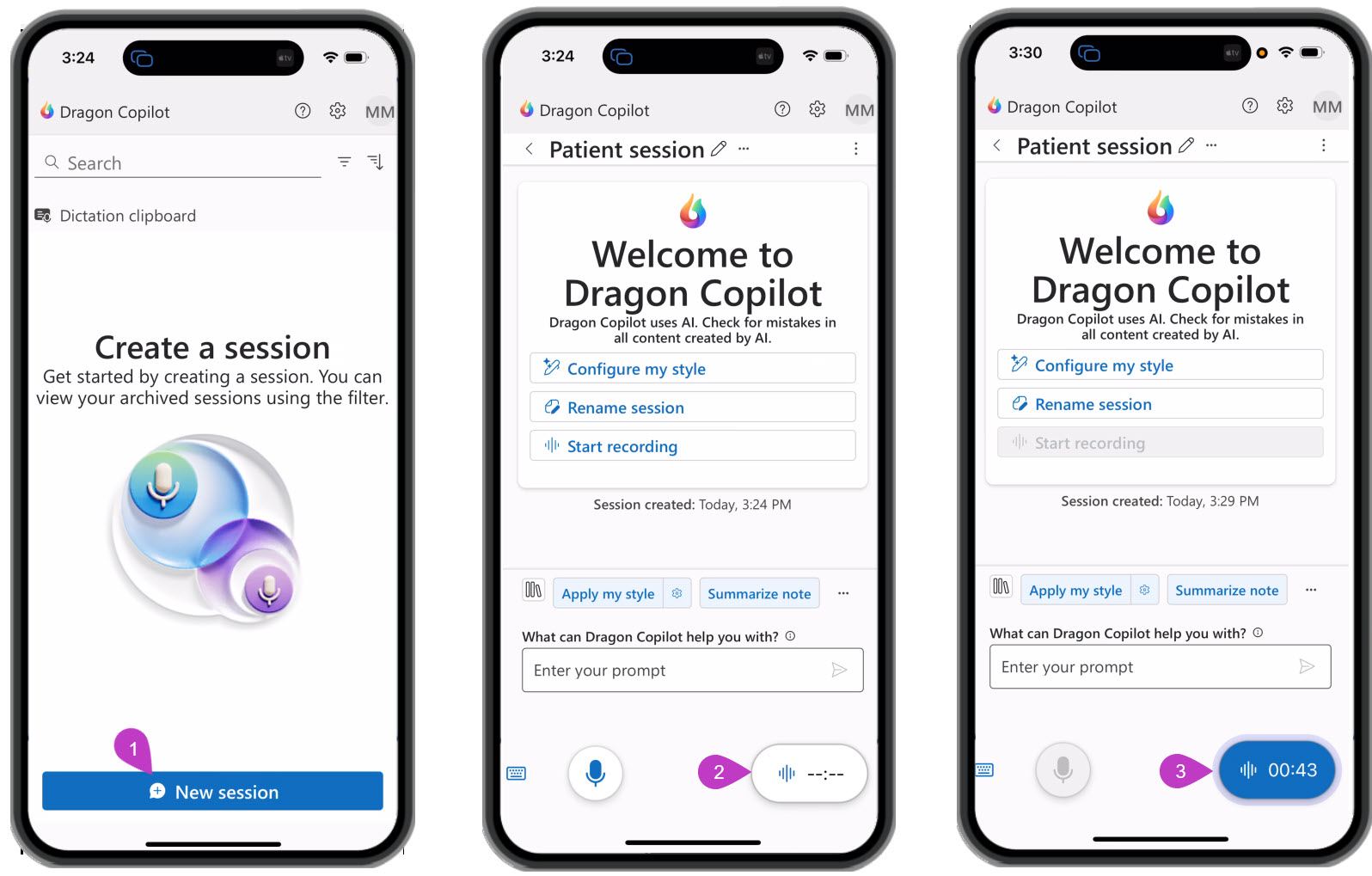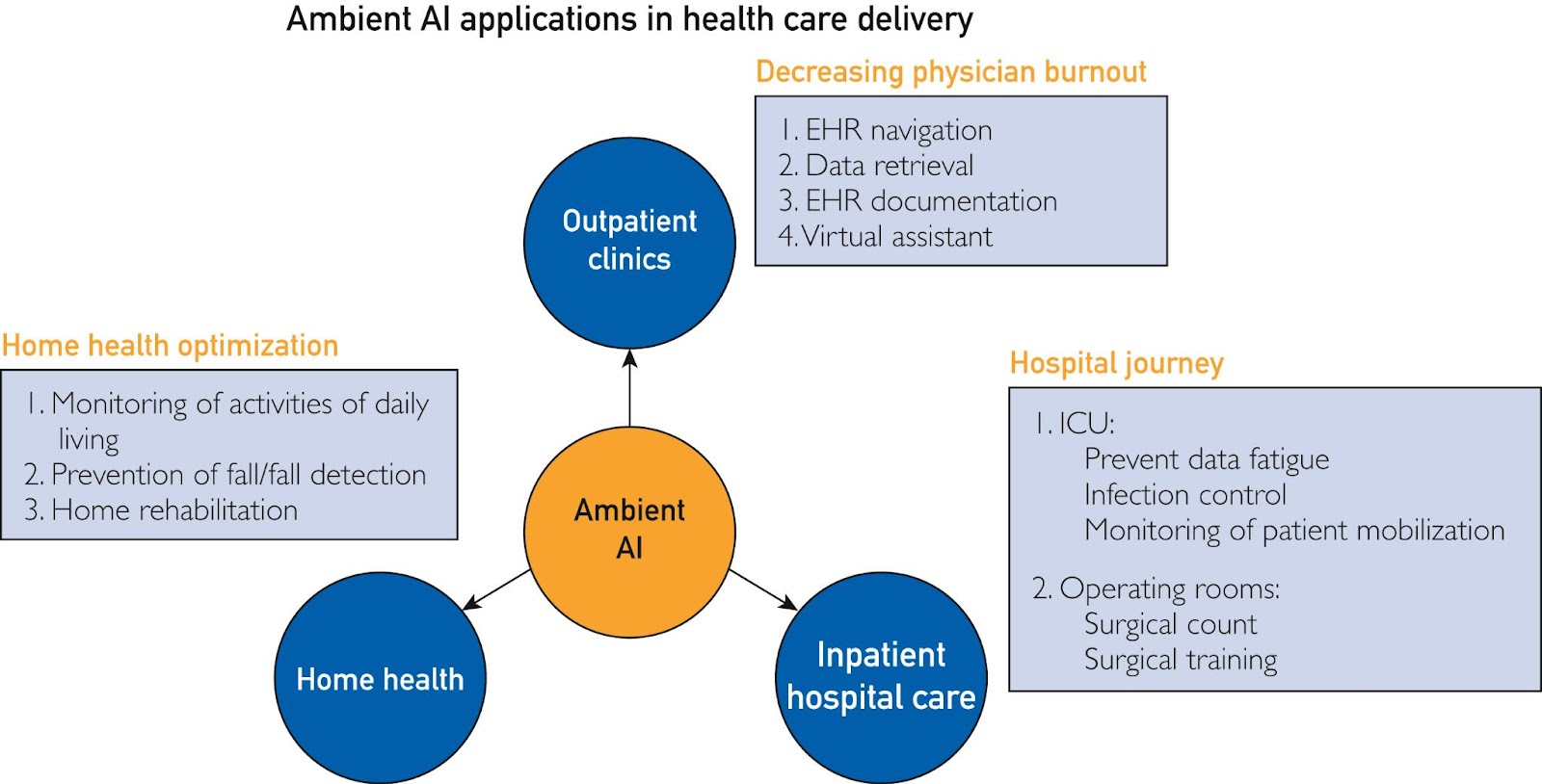20 Minutes to 2: Ambient AI's Impact on Healthcare
Ambient AI is revolutionizing healthcare: cutting documentation time in half and allowing clinicians to spend more time on patient care. Learn from real success stories and implementation strategies.
Northwestern Medicine achieved 112% return on investment with ambient AI, saving 7 minutes per encounter while adding 5 additional appointments per clinic day through automated documentation.
Ambient intelligence in healthcare enables clinicians to spend 73% of their time on patient care versus 25% on administrative tasks—a complete reversal of current time allocation.
Healthcare's governance-first approach to ambient AI creates templates for other industries, from financial services capturing loan conversations to legal firms streamlining document review processes.
Picture this: A nurse at a leading hospital walks into a patient's room at 7 AM for the morning shift handoff. Traditionally, she would spend the next 20 minutes sifting through dense electronic health records, trying to piece together the patient's overnight journey from fragments of notes across multiple systems. But today is different. An AI-generated summary greets her with a crisp, clinical narrative in plain language: the patient's pain levels improved overnight, the antibiotic is working, and discharge planning should begin today.
What once took 20 minutes now takes 2.
This is becoming a standard process at hospitals across America, where working summaries created using ambient AI have achieved a 90% approval rating from nurses.
AI is transforming numerous aspects of healthcare, from drug discovery to disease detection and more. But ambient AI in healthcare represents one way in which AI is directly impacting doctor-patient relationships in real-time. In this piece, we’ll cover ambient intelligence case studies, pillars of success, and what other fields can learn from healthcare’s successful implementation.
Ambient AI: More Personable, Focused Physicians
Ambient AI refers to artificial intelligence systems that operate seamlessly in the background during clinical encounters, using voice recognition and natural language processing to capture, analyze automatically, and document patient-provider conversations without interrupting the care delivery process.
Unlike traditional documentation methods that require clinicians to type notes during or after visits, ambient AI listens to conversations and generates structured clinical documentation in real-time. Beyond documentation, ambient AI enhances communication across healthcare teams by generating clear summaries for handoffs, reduces physician burnout by automating administrative tasks, and increases attentiveness to patient needs. The technology captures subtle patient concerns that might otherwise be missed while creating higher-quality, more comprehensive medical records.
Ambient AI is already delivering measurable results, demonstrating how intelligent listening technology is reshaping clinical workflows while improving patient experiences. Here are two primary ways ambient AI is improving healthcare:
Saving Time with Patient Interactions Microsoft Dragon Copilot, formerly Nuance DAX, represents the most successful deployment of ambient AI in healthcare to date. Built on GPT-4 and integrated directly with Epic's electronic health record system, this generative AI platform now serves more than 150 health systems nationwide. Northwestern Medicine achieved a 112% return on investment with clinicians saving 7 minutes per encounter and adding 5 additional appointments per clinic day. University of Michigan Health-West saw documentation time drop by 50%, while patients reported physicians were more personable (85%) and focused (80%) during visits.
Similar to Dragon Copilot, Suki Assistant’s ambient AI technology works across multiple electronic health record systems simultaneously. Suki offers full bidirectional integration with Epic, Oracle Health, athenahealth, and MEDITECH, allowing clinicians to prechart in their EHR (electronic health record) and complete documentation in Suki seamlessly. The platform delivers an average $1,688 in incremental monthly revenue per user through higher coding accuracy and increased patient throughput, while achieving a 75% adoption rate with clinicians completing documentation 72% faster than traditional methods.

Improving Clinical Decision Making
Specifically targeting clinical decision support, Pieces Technology represents the cutting edge of ambient AI in healthcare for clinical decision-making. Their specialized large language models improved discharge planning accuracy from 20.5% to 73.7%, generating twice as many discharge predictions (70,388 vs. 25,743) compared to manual processes. This breakthrough made them the first health system in the nation to deploy generative AI at scale in inpatient environments, creating unified clinical summaries that coordinate multidisciplinary teams.
As Joe Petro from Microsoft Health & Life Sciences notes, "In healthcare, ambient intelligence will be the driving force for restoring the joy of practicing medicine and providing a better experience for patients."
"In healthcare, ambient intelligence will be the driving force for restoring the joy of practicing medicine and providing a better experience for patients."
—Joe Petro, Corporate Vice President, Microsoft Healthcare & Life Sciences
Mastering Implementation: 3 Pillars of Success
The deployment of ambient AI in healthcare requires careful attention to three interconnected success factors.
The Foundation: Compliance, Privacy, and Governance
Privacy and governance form the foundation. Healthcare organizations must comply with HIPAA (Health Insurance Portability and Accountability Act), federal regulations that protect patient health information from unauthorized disclosure. This means any AI system that processes patient conversations or medical records must meet strict standards for data encryption, access controls, and audit trails. Companies like Truveta have achieved SOC 2 Type 2 attestation and ISO 27001 certification—industry-recognized security standards that demonstrate their ability to protect sensitive healthcare data. Rather than viewing these requirements as barriers, forward-thinking organizations are discovering that robust governance frameworks create competitive advantages by building trust with patients, providers, and regulators.
“There's so much good, so much incredible potential here to unlock from continuing to invest in making this available… in the right way and being proactive to try and avoid any misuse. It's worth persevering and trying to keep investing in enabling the research, enabling the transparency, earning the trust.”
—Terry Myerson, CEO of Truveta

The Framework: Seamless Workflow Integration
Workflow integration represents the make-or-break factor for ambient AI in healthcare adoption. The "last mile" problem occurs when AI systems work brilliantly in demonstrations but fail to integrate seamlessly into real clinical workflows. Technical integration requires AI outputs to appear directly within existing electronic health record systems without forcing clinicians to switch between multiple applications. Dragon Copilot exemplifies this approach by recording conversations and drafting notes directly in Epic's mobile app, eliminating context-switching. Workflow integration ensures AI enhances rather than disrupts established processes. For example, when AI suggests treatment modifications or generates clinical summaries, it provides clear citations and reasoning that clinicians can validate, transforming AI from a "black box" into a trusted colleague.
The Make-or-Break Element: Upskilling and Collaboration
The bottleneck for ambient AI adoption has shifted from technical teams to clinicians, nurses, and administrative staff, who must learn to collaborate with AI systems. Currently, fewer than 24% of healthcare organizations offer AI education programs. However, this transformation is enabling unprecedented human-AI partnerships that multiply rather than replace clinical expertise. As Dr. Margaret Lozovatsky from the American Medical Association notes, "We have seen that become almost table stakes in our health care settings, where most organizations are using ambient listening in their health care environment, and our physicians are loving it."
Most critically, ambient AI in healthcare applications allows clinicians to spend 73% of their time on patient care versus 25% on administrative tasks—a complete reversal of current time allocation.
"We have seen that become almost table stakes in our health care settings, where most organizations are using ambient listening in their health care environment, and our physicians are loving it."
—Margaret Lozovatsky, MD, FAMIA
VP of Digital Health Innovations, American Medical Association
Cross-Industry Takeaways
Healthcare's methodical approach to ambient AI offers a sophisticated playbook that other industries can look to, whether for ambient AI or another application. The sector's success stems from a fundamental shift in how organizations think about AI implementation—prioritizing sustainable adoption over flashy demonstrations.
The healthcare sector's strategy starts with high-impact, lower-risk use cases. Rather than immediately targeting high-stakes clinical decision-making, ambient AI in healthcare focuses on administrative processes like documentation and discharge planning that offer significant workflow improvements with manageable risk profiles. Here’s how this approach could translate to other sectors:
- Financial services: capture and structure customer conversations during loan applications
- Legal firms: deploy ambient AI for document review and discovery processes
- Manufacturing: start with quality control documentation rather than safety-critical production decisions.
The theme is that early wins in administrative areas build the organizational confidence and expertise necessary for more complex applications.
Healthcare's governance-first model demonstrates how regulatory compliance transforms from an operational burden into a competitive advantage. The sector's experience with HIPAA compliance, which requires detailed audit trails and data protection measures, has created frameworks that other regulated industries desperately need.
Most importantly, healthcare's emphasis on human-AI partnership over replacement creates more sustainable adoption patterns that work better than automation-focused approaches. The sector proves that AI adoption accelerates when technology amplifies human capabilities rather than threatening job security. We see this in education, where AI enhances teacher effectiveness with AI tutoring assistants that provide real-time insights while preserving the human connection students need. And retail organizations are empowering customer service representatives with ambient intelligence that captures conversation context and suggests solutions while maintaining personal relationships.
A More Connected Future
Back to that nurse walking into the patient room at 7 AM. She gets everything she needs to know much faster—but those 18 minutes saved? She spends them listening to her patients' concerns, explaining the treatment plan, and building the human connection that technology should enable, not replace.
That is what has healthcare professionals so excited about this technology.
Healthcare's methodical approach to ambient AI is pioneering the next phase of AI adoption across any sector where precision, trust, and human expertise remain paramount. Organizations mastering the "last mile" of AI integration will create compounding advantages: better outcomes generate more data, enabling further innovation in a virtuous cycle increasingly complex for competitors to replicate.
The momentum continues. Microsoft's survey of 879 clinicians reveals providers are achieving human parity in converting doctor-patient conversations to customized clinical notes. The technology has progressed from zero users to serving more than 600 major healthcare systems, producing over 3 million episodes of care per month. This scale provides the data and experience necessary for continuous improvement, benefiting the entire ecosystem.
Healthcare's journey with ambient AI demonstrates that organizations investing in thoughtful, systematic AI deployment today will define the standards and practices shaping the next decade of business technology adoption.
The promise isn't just efficiency—it's restoring the joy of practicing medicine, one conversation at a time.





.svg)






_0000_Layer-2.png)

